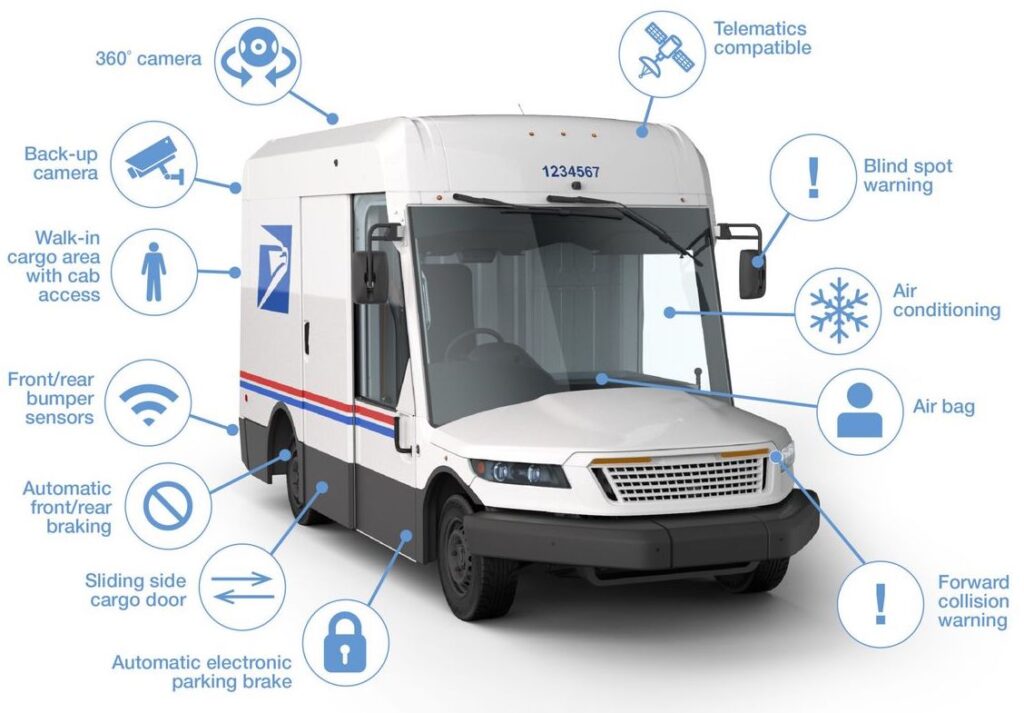The USPS is embarking on a bold journey to electrify its fleet, aiming for a greener, more financially stable future. However, the path to an all-electric fleet is fraught with significant challenges that could undermine these ambitious goals.
They are in the midst of transitioning their fleet of Grumman LLVs (the ubiquitous mail trucks that you see) to a fleet that is composed primarily of EVs. Depending on the governmental source, EVs now make up 40%-100% of all purchases, but what does this mean for the USPS?

Source: https://www.uspsoig.gov/focus-areas/focus-on/focus-on-next-generation-delivery-vehicles
In 2021, the USPS published its “Delivering for America” transformation plan where they detail how they will become financially self-sufficient again. It dedicates half of the $40 billion plan to fleet modernization. (Note: The USPS's ongoing financial challenges are largely due to a 2006 mandate requiring the agency to pre-fund retiree health benefits 75 years in advance. This aspect, however, is beyond the focus of this article.)
U.S. Postal Service's Next Generation Delivery Vehicle
While current projections show that their delivery fleet will reach 66,000 EVs by 2028, the USPS is still evaluating the feasibility of total electrification. Oshkosh will be producing the Next Gen Delivery Vehicles, and based on their current production rates, that number will almost certainly fall short.
Given the history of USPS initiatives, as well as the whims of congressional oversight, the end result may be drastically different than they anticipate by the end of the plan in 2031.

Source: GAO | GAO-23-106677
USPS's Electrification Journey
Let’s examine how the USPS got to this point and what the feasibility is of making the USPS fleet 100% electric.
The reason why the USPS is transitioning its fleet of gas-powered vehicles to largely EVs is pretty straightforward—it has been pushed by governmental bodies that fund the USPS to adopt EVs in order to curb carbon emissions since the USPS has the largest fleet of any department with close to 250,000 vehicles. Transitioning to all-electric is being touted as a panacea, but several factors make this a bad idea for the USPS.
Firstly, I’ll cite that gasoline cost is roughly equivalent to electricity cost on a per-mile basis, but the USPS is relying on saving hundreds of millions of dollars over the lifetime of the fleet.
Relying on this assumption is both unrealistic and counterproductive as energy prices are fluid and the electricity upon which they rely is produced by fossil fuels (65%). More investment/less red tape in nuclear power development could certainly make this point moot, but there is currently no governmental push to do this.
Secondly, a more pointed example that we all witnessed recently is the cold-weather-related difficulties of both the charging stations and the cars themselves. The charging stations have reliability issues that could be remedied with better engineering, but the batteries will, for the foreseeable future, rely on a battery chemistry whose capacity and cycle life are drastically decreased by cold temperatures.
At 0° F, the capacity drops to roughly 65% depending on the specific chemistry, but more importantly, the allowable charge rate to avoid permanent damage is just 10-20% of normal. This has obvious implications for range and daily vehicle deployment in cold-weather regions. There are several ways to deal with this problem like pre-heating and route planning, but both add cost to a plan that is heavily reliant on savings.
"Transitioning to all-electric is being touted as a panacea, but several factors make this a bad idea for the USPS."
Maturity and Risks in the EV Industry
The last point I’ll cover here is around the state of the EV industry itself. While the basic combination of motor + battery + controller has been utilized for decades, the maturity of the EV industry is still quite low.

Source: USPS Office of Inspector General
There are certainly major players producing millions of vehicles per year, but the battery and charger technology is still in flux with new advancements being made each year that could easily obviate the “next-generation delivery vehicle” within a few years. If that were to occur then the USPS may be left with a very expensive fleet of out-of-date vehicles, in comparison to today’s relatively inexpensive out-of-date vehicles. Such a large investment of the public’s money should not be going into an as-yet-unproven paradigm in the hopes that it will solve all of the USPS’ operational issues.
"While the potential benefits are clear, the challenges—such as fluctuating energy costs, cold-weather performance issues, and evolving EV technology—pose significant risks."
Key Takeaway
The USPS's ambitious plan to transition to an electric vehicle fleet represents a significant step towards sustainability and financial self-sufficiency. While the potential benefits are clear, the challenges—such as fluctuating energy costs, cold-weather performance issues, and evolving EV technology—pose significant risks.
With so many unknowns, the USPS may be stumbling into an even larger cost-overrun scenario that leads to ever-widening budget gaps that, again, must be filled by additional government funding.
About the Author
Justin Wilcox is a Senior Solution Architect with JBF Consulting and has 20+ years of experience in the Transportation and Supply Chain industry. He has lead numerous initiatives with an emphasis on solution design, modeling, and TMS implementations to create highly customized logistics solutions, especially within complex supply chain networks.